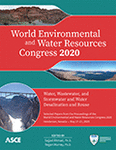World Environmental and Water Resources Congress 2020
Effectiveness of Retrofitting Low Impact Development in Parking Lots to Reduce Flooding
Publication: World Environmental and Water Resources Congress 2020: Water, Wastewater, and Stormwater and Water Desalination and Reuse
ABSTRACT
Urban flooding is a manmade disaster and a recurrent problem in cities. Flooding can be reduced by increasing land surface perviousness and reducing connectivity between impervious surfaces. This research compares the effectiveness of five low impact development retrofitting options for flood remediation in a parking lot including porous asphalt, gravel and grass swale strips, grass pavers, and concrete grid pavers. Digital elevation model (DEM), land cover, and hydrologic soil group data are used to develop watershed model in a geographic information system (GIS)-based framework. This framework is capable of watershed delineation from DEM, runoff generation and routing, and inundation mapping. Soil conservation service (SCS) curve number method is used to estimate discharge hydrograph and GIS spatial analyst is used to map inundation. Due to a lack of observed discharge data, calibration is performed over data resolutions and drain inlet clogging factor utilizing flood information from news reports, photographic evidence, and observed watermark of inundation extent. The change in flooding for the five remediation measures is simulated for Blacklot parking area at the University of Nevada Las Vegas campus. The results show that the watershed flooding reduces with a decrease in curve number of the surface. Flooding is reduced by 26% for porous asphalt, and only 2.9% for grass and gravel swale strips. The flooding is significantly reduced for grass pavers (46%), while flooding was completely prevented by concrete grid pavers. This research reveals that concrete grid pavers are an effective option to avoid flooding in Blacklot area. This study provides a useful insight about low impact development retrofitting in parking lots to reduce urban flooding.
Get full access to this article
View all available purchase options and get full access to this chapter.
REFERENCES
Abedin, S. J. H., & Stephen, H. (2019). GIS Framework for Spatiotemporal Mapping of Urban Flooding. Geosciences, 9(2), 77.
Brattebo, B. O., & Booth, D. B. (2003). Long-term stormwater quantity and quality performance of permeable pavement systems. Water research, 37(18), 4369-4376.
Cronshey, R., McCuen, R., Miller, N., Rawls, W., Robbins, S., & Woodward, D. (1986). Urban hydrology for small watersheds—TR–55: Washington. DC, US Dept. of Agriculture, Soil Conservation Service, Engineering Division, Technical Release, 55, 164.
EPA, (1999). Storm Water Technology Fact Sheet Vegetated Swales. Report 832-F-99-006. US Environmental Protection Agency. Office of Water. Washington, D.C.
Feyen, L., Barredo, J. I., & Dankers, R. (2008). Implications of global warming and urban land cover change on flooding in Europe. Water and urban development paradigms–Towards an integration of engineering, design and management approaches, 217-225.
Genovese, E. (2006). A methodological approach to land use-based flood damage assessment in urban areas: Prague case study. Technical EUR Reports, EUR, 22497.
Goforth, G. F. (1983). An advancement in hydraulic modeling of porous pavement facilities. In Proceedings of Stormwater and Water Quality Model Users Group Meeting, January 27-28, 1983 (Vol. 83, No. 15, p. 237). Environmental Research Laboratory, Office of Research and Development, US Environmental Protection Agency.
Hunt, W. F., & Collins, K. A. (2008). Permeable pavement: Research update and design implications. North Carolina Cooperative Extension Service. Raleigh, NC.
Konrad, C. P. (2003). Effects of urban development on floods. USGS Fact Sheet FS-076-03. U.S. Geological Survey-Water Resources, 1201 Pacific Avenue, Suite 600, Tacoma, WA 98402.
Pandit, A., & Heck, H. H. (2008). Estimation of Curve Numbers for Concrete and Asphalt. In World Environmental and Water Resources Congress 2008: Ahupua'A (pp. 1-1). ASCE.
Putnam, B. J. (2010). Field performance of porous pavements in South Carolina. Proceedings of the 2010 South Carolina Water Resources Conference, October 13-14, 2010, Columbia Metropolitan Convention Center
UNHSC Design Specifications for Porous Asphalt Pavement and Infiltration Beds. University of New Hampshire Stormwater Center (UNHSC). (2014). Retrieved from: http://www.unh.edu/erg/cstev
Information & Authors
Information
Published In
World Environmental and Water Resources Congress 2020: Water, Wastewater, and Stormwater and Water Desalination and Reuse
Pages: 93 - 103
Editors: Sajjad Ahmad, Ph.D., and Regan Murray, Ph.D.
ISBN (Online): 978-0-7844-8298-8
Copyright
© 2020 American Society of Civil Engineers.
History
Published online: May 14, 2020
Published in print: May 14, 2020
Authors
Metrics & Citations
Metrics
Citations
Download citation
If you have the appropriate software installed, you can download article citation data to the citation manager of your choice. Simply select your manager software from the list below and click Download.
